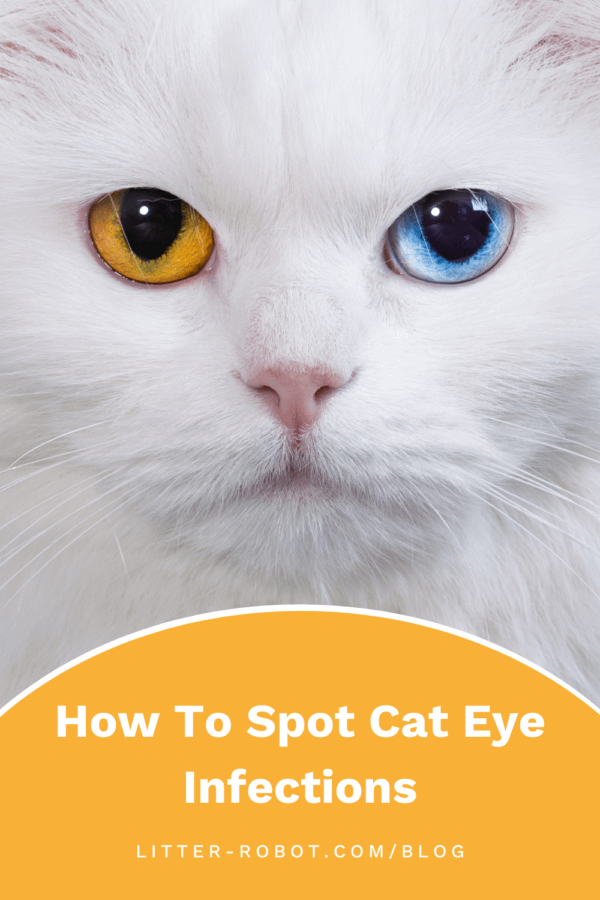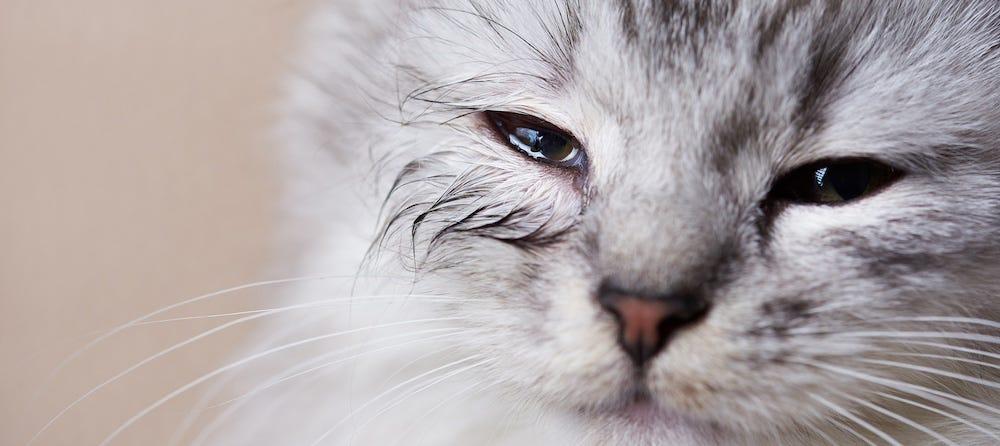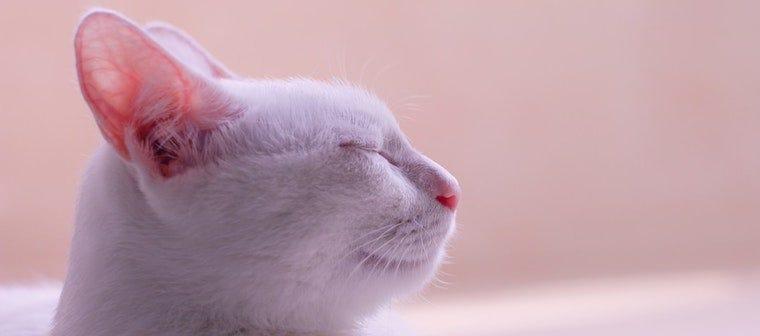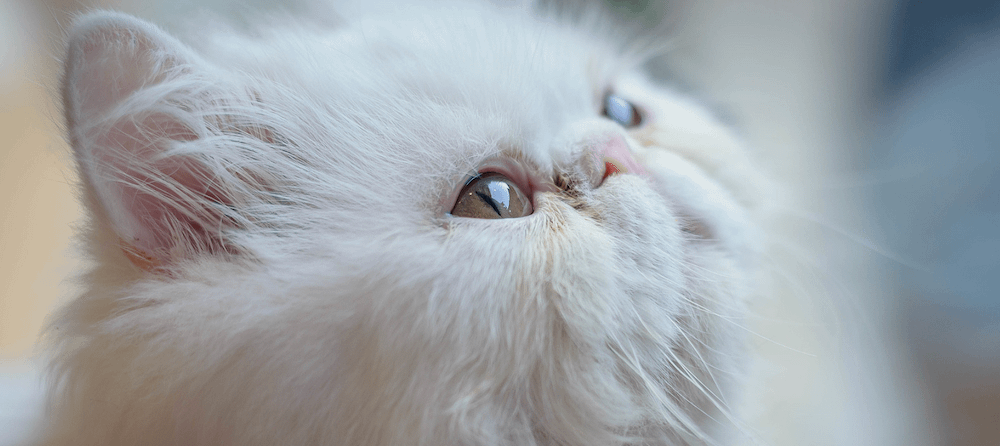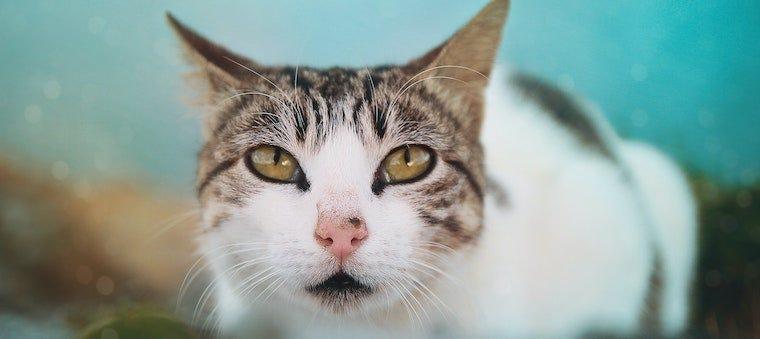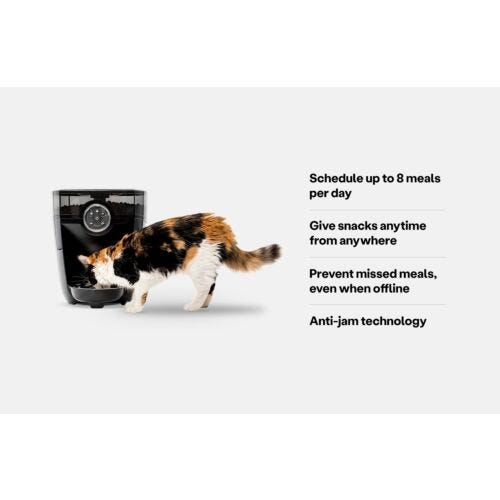Partially authored by Justine Lee, DVM
Cat lovers will agree that felines have the most beautiful, expressive eyes. From their “window to the soul,” you can tell when your cat is content versus when your cat is giving you the stink eye. But like humans, cats can develop eye problems.
Cat eye infections can be caused by a variety of reasons, some of which are more serious than others. If you notice that your cat’s eyes look infected, seeking treatment as soon as possible is critical in order to avoid more serious health issues.
If you're wondering what cat eye infections look like, you should know that symptoms will often include tearing, redness, or discharge. Here's more about what you need to know regarding cat eye infections.
Anatomy of the eye
First, let’s start with the anatomy of the eye. The anatomy of the eye is very similar between dogs, cats, and humans—they all have similar structures like the cornea, pupil, iris, lens, retina/tapetum lucidum, and the optic nerve. All of these parts of the eye are housed in the “globe” of the eye (the entire “eyeball”). Dogs and cats also have a third eyelid in the inside corner of their eye which helps protect their eye from trauma, injury, or even dryness. The entire globe is surrounded by a thin sheet of whitish/pink-tinged tissue called the conjunctiva, which is under the eyelids. Each of these delicate parts of the eye play an important role including:
- Cornea: the clear “windshield” of the eye, which protects the eyeball
- Pupil: the vertical slit-like to round part of the center of the eye that lets light into the back of the eye
- Iris: the pigmented (e.g., green, blue, brown, copper, etc.) circular membrane that surrounds the pupil and also responds to light
- Lens: the invisible “contact lens-like” structure that helps the eye focus
- Retina/tapetum lucidum: the thin membrane that lines the inside part of the eyeball that sends the visual information to the brain; this is what often results in “red eye” in photos taken with a flash. The rods and cones of the eye live in this area, and in the cat, contribute to such astute night vision
- Optic nerve: the large nerve that connects from the retina to the brain
- Sclera: the “white” of the eye typically hidden by the eyelids
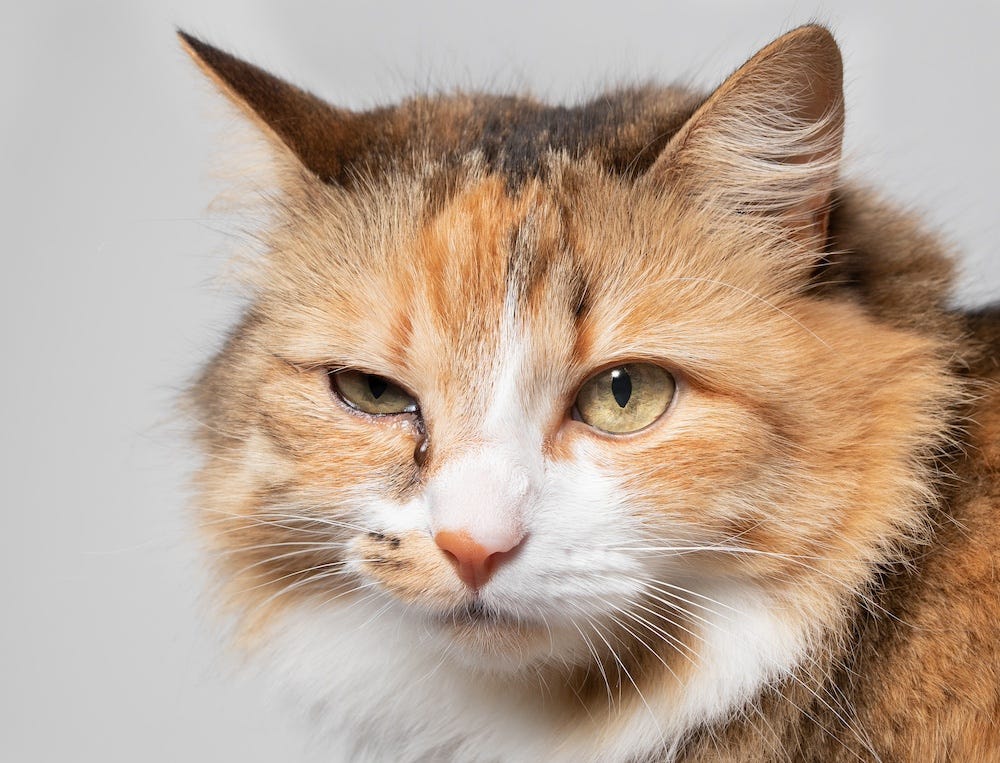
What are the signs of common cat eye problems?
Clinical signs of ocular disease in your cat will vary, depending on where anatomically the eye problem may be. General signs of eye problems in cats include:
- Excessive tearing (called epiphora)
- Squinting
- Redness to the eye
- Discharge from the eye (e.g., green, yellow, cloudy)
- Discoloration or cloudiness of the surface of the eye
- Third eyelid elevation
- Swelling or prominent “pink” conjunctival tissue
- Keeping the eyes closed
- Uneven or inappropriately dilated pupil(s)
- Black spots on the eye
- Haziness or lack of “sharpness” to the iris
- Abnormal appearance to the eye
- Eye pain or discomfort
- Sneezing or drooling (from a secondary upper respiratory infection)
- Pawing at the eye
- Discoloration of the sclera (e.g., like bruising or bleeding or even a yellow appearance from liver disease)
- Lumps or masses or asymmetry of the eyelids
- Sensitivity to light
- Sunken eye
- Bulging or protruding of the eye (called exophthalmos)
- Vision loss/blindness
As you can see, that’s a pretty long list of signs that your cat has an eye problem! If you notice any of these signs, get to a veterinarian immediately!
Cat eye infections and other eye issues
If your cat's eyes are looking cloudy, red, or swollen, your cat might have an eye infection. Also, if you notice cat eye discharge and your cat pawing at his or her face a lot, these could also be signs that your cat has an eye infection. Here are a few types of cat eye infections and eye problems you should be on the lookout for.
Infections
Types of cat eye infections include viral, bacterial, fungal, protozoal, or rarely parasitic. These infections can lead to medical issues including conjunctivitis, uveitis, and even cataracts. Cats commonly show symptoms as a result of an upper respiratory infection (URI).
Some symptoms to watch for include discharge from the eye, tearing, squinting, eye pain, redness, ocular cloudiness, and changes in pupil size.
Bacterial or ulcerative keratitis
A cat’s cornea is the dome-shaped surface that covers the front of their eyes. If that surface encounters trauma, most commonly from scratches, it can cause feline bacterial keratitis, or an inflammation of the surface of the eye due to infection with a bacteria. Ulcerative keratitis is inflammation of the cornea that causes damage to the surface.
Burns
Cats can experience ulcers in their eyes from trauma other than blunt force. In some cases, cats have been known to experience burns on the eyes due to rubbing their eye against a rough surface. Another common cause of burns to the eyes is chemical burns of the cornea. This can happen when irritants get in the eyes, such as shampoos, chemicals, dust, drywall, or other liquids.
Other eye problems
Cats have unique eyes, but just like humans, they can encounter other simpler issues with their eyes. Epiphora, or watery eyes, can occur as the result of blocked tear ducts. Likewise, a condition called keratoconjunctivitis sicca, or dry eye, is a chronic lack of tear production, which can lead to red eyes, inflamed corneas, and blindness, if left untreated. Allergies, third eyelid problems, and objects becoming lodged in the eyes can also affect your feline’s optic health.
Surgery
Cats that have undergone any type of surgery on their eyes are at higher risk of infection if their eyes are not properly cared for after the procedure. A build-up of discharge or constant pawing at the irritated area can lead to bacterial infection or eye trauma.
What tests does my veterinarian need to do to diagnose an eye problem in my cat?
Once you get to your veterinarian, they’ll need to get a thorough history, do a thorough physical examination, and do specific ocular tests. Specific questions your veterinarian may ask you include:
- Does your cat go outdoors?
- Is your cat vaccinated for feline leukemia (FeLV)?
- Does your cat fight with other animals?
- Is your cat drinking or urinating excessively?
- Have you introduced any new cats to your household?
- Is there any history of feline infectious peritonitis (FIP) or medical problems in your cat’s parents or siblings?
As for ocular tests, these will include a Schirmer tear test (STT) to test the tear function of your cat’s eye, a fluorescein stain to see if your cat has scratches or ulcers on the eye, corneal cytology to look at the cells on your cat’s cornea, and sometimes even an intraocular pressure to test for glaucoma.
Depending on what your cat is diagnosed with, it may even require more extensive testing to rule out a systemic (e.g., whole body) infection. These include blood tests to see if your cat has underlying infections (like FeLV or FIP) or viral infections. Additional blood work to check your cat’s general health (like a complete blood count and chemistry panel) should also be done to rule out kidney disease, hyperthyroidism, liver problems, an infection, and more. A urine test may need to be done to rule out diabetes mellitus, and a blood pressure should be done to rule out hypertension.
What is the treatment for common cat eye problems?
Depending on what the underlying cause is, treatment will vary from topical ophthalmic antibiotics, oral and topical antiviral medications, pain medications, atropine to dilate the pupils, a funnel hat or e-collar to prevent further injury, steroid drops, or even different types of surgery.
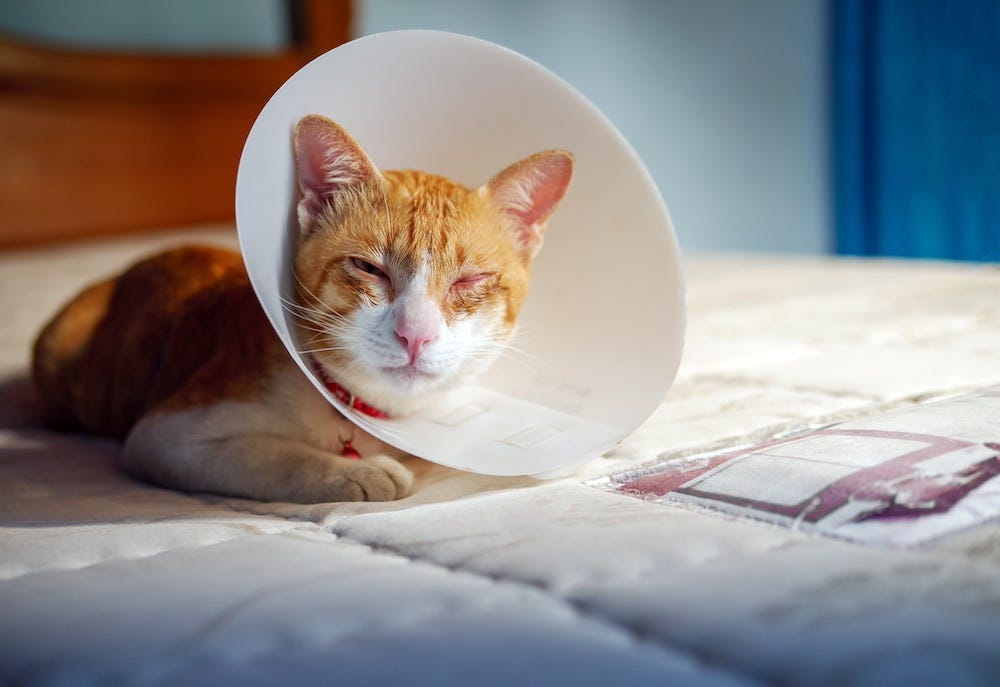
Protect your cat’s eyes
There are ways to help keep your feline friend’s eyes healthy and sharp! Here are 6 ways to care for your cat's optic health.
- Check your cat's eyes regularly. If you notice any masses, discoloration, redness, swelling, cloudiness, excessive tearing, or discharge, it could be a sign of infection. Also, pay attention to whether your cat is scratching or rubbing his or her face a lot. If you notice this, take your cat to the vet.
- Set up routine vet visits to head off any eye problems before they get serious. Routine physical exams and blood work can give you insight into the type of care that your cat needs. Often, eye problems indicate a bigger underlying medical problem, such as chronic kidney disease, diabetes mellitus, and hyperthyroidism.
- Quarantine new cats in the household for 1-2 weeks. This will ensure that a URI isn’t transmitted to the original house cats. If you are introducing cats to each other, do so slowly and make sure to trim all nails before any cats connect.
- Monitor your cat's interactions with other pets in the home. A common cause of eye problems is due to injury to the eye inflicted by another pet. It can be caused by friendly playing or even a minor fight. But in either case, supervision between animals can help keep your cat's eyes from becoming infected.
- Keep your cat indoors to help them avoid running into eye problems. Whether those are problems caused by traumatic events, irritants in the environment, interactions with toxic chemicals, or contact with harmful bacteria, the outdoors can easily lead to harm for your cat’s eyes.
- Trim your cat's nails regularly to help reduce the chances of your cat accidentally scratching his or her eyes, or the eyes of another pet in the house. This is important because it will minimize a rip in the skin where bacteria can form and subsequently irritate the eye in general.
- Finally, keep your cat's litter box, beds, and other commonly used areas clean to avoid bacterial overgrowth. Litter-Robot cleaner spray and Litter-Robot cleaner wipes use all-natural ingredients that are designed to eliminate organic material, stains, and odor. The bio-enzymatic technology, combined with plan-based cleaners, is safe for your pet. Plus, it will keep their litter box and space cleaner than ever!
What is a cat stye?
Also referred to as a hordeolum, a stye is a red, painful lump either near the edge of the eyelid or on the inner part of the eyelid. It often looks like a boil or a pimple, and may be filled with pus.
Styes result from an acute infection of the oil glands of the eyelid, and they occur after glands have become clogged. The eye may feel irritated and itchy as a result. Other symptoms can include swelling, discomfort when blinking, light sensitivity, and watering of the eye.
How to spot a cat stye
If you notice your cat’s eye is swollen, discharging puss, or causing your cat to scratch their eyes, take a closer look at the eyelid. If a stye is present, you'll notice a small bump that looks like a pimple or boil on the edge or inner part of the eyelid.
How a cat gets a stye
Cats can get styes in various ways, whether that be heat, allergic reactions, or even diabetes. Let's take a closer look at some of the ways your cat can get a stye.
Heat and moisture
Heat and moisture in the air can produce a breeding ground for fungi, which can cause fungal infections for your cat. If fungi are present in the environment, they can enter your cat's system via a cut in their skin, which can ultimately cause a stye to form.
Fungi are found in soil, feces, and the general environment. If your cat has a break in their skin near or around the eyelid, simply touching the face can introduce bacteria or fungi into the eye, which can lead to a stye.
Allergic reactions
Cats can have allergic reactions to pollen, dust, smoke, shampoo, fleas, chemicals, and other parasites. Whether your cat's eyes are irritated due to something in the air or because they’re dealing with a pest problem, this can lead to excessively scratching their eyes. The skin around their eyes can break and bacteria can enter, causing a stye.
Trauma
Trauma can also cause your cat's eye to become irritated and a stye to form. This can include your cat getting hit in the eye, getting in a fight with another cat, or anything that causes the skin around the eyelid to break. When the skin breaks, bacteria can get inside of the tear, causing a stye.
Diabetes
Since diabetes weakens the immune system, acute infections of any kind are a common side effect of diabetes. The eyelids of humans and cats alike are both very susceptible to infections, which can cause a stye to form.
What happens if a stye remains untreated?
Many pet parents wonder, Will my cat's eye infection go away on its own? The answer to this question is that styes are a type of infection that often goes away on its own. However, it's likely your cat will continue to irritate the affected area by scratching their eye. An untreated stye can get worse and cause the whole eye to become infected. Once the infection reaches the eye, if left untreated, it can cause your cat to lose some vision or even become completely blind in the infected eye.
How do you treat a stye?
If you notice your cat has a stye, be sure to keep their eyes clean. The process of how to clean cat eye discharge is pretty simple! All you have to do is use a moistened cotton ball to gently wipe away the discharge with a sterile eye wash.
A warm compress can also help soothe your cat’s eye. Run a washcloth under warm water and then gently press it against your cat's eyelids—but make sure the water isn't hot. Never use over-the-counter medicated eye drops on your cat either unless specifically instructed by your vet.
Help keep your cat healthy
From the way cats see the world to the beautiful vibrant colors of their eyes, keeping their optic health in check is a must for any pet parent! Take preventative measures and address eye problems as soon as they occur. Remember that eye issues could mean that there is an underlying medical problem in your cat. When in doubt, take your cat to the vet!
FAQs
Why does my cat keep getting eye infections?
Kittens are more susceptible to eye infections due to the fact that they have weaker immune systems. If your cat has feline herpes virus, it can also lead to acute conjunctivitis. Other reasons your cat might be getting eye infections include autoimmune disease, cancer, eye trauma, or feline leukemia.
Can cat eye infections spread to humans?
The viruses and bacteria that cause eye infections in cats cannot be transmitted to humans.
Can you treat cat eye infections at home?
While there are remedies that you can implement to ease the pain caused by cat eye infections, it’s best to consult your vet so that you can seek the proper diagnosis and treatment for your pet.
Sources:
- Conditions of the Eyelids and Ocular Adnexa in Dogs and Cats
- Feline bacterial keratitis: Clinical features, bacterial isolates, and in vitro antimicrobial susceptibility patterns
- Corneal Ulcers (Ulcerative Keratitis) in Cats
